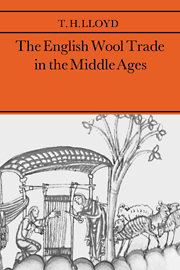Book contents
- Frontmatter
- Contents
- List of Tables and Maps
- Preface
- Abbreviations used in Notes and Bibliography
- 1 The growth of the Flemish connection
- 2 The end of the Flemish ascendancy
- 3 The Italian hegemony
- 4 The English triumphant
- 5 Edward III – woolmonger extraordinary
- 6 Quest for a staple policy
- 7 The evolution of the Calais staple
- 8 The decline of the wool trade
- 9 Marketing the wool
- Notes
- Bibliography
- Index
8 - The decline of the wool trade
Published online by Cambridge University Press: 10 December 2009
- Frontmatter
- Contents
- List of Tables and Maps
- Preface
- Abbreviations used in Notes and Bibliography
- 1 The growth of the Flemish connection
- 2 The end of the Flemish ascendancy
- 3 The Italian hegemony
- 4 The English triumphant
- 5 Edward III – woolmonger extraordinary
- 6 Quest for a staple policy
- 7 The evolution of the Calais staple
- 8 The decline of the wool trade
- 9 Marketing the wool
- Notes
- Bibliography
- Index
Summary
In 1429 was enacted the parliamentary legislation known as the bullion and partition ordinances. Whatever their intention these measures contributed to a further decline in wool exports. Munro has strongly emphasised that the legislation originated with the Crown, as part of its efforts to obtain bullion at the expense of Burgundy. The partition ordinance he sees as a bribe to obtain the cooperation of the greater wool merchants. He contrasts his position with that of Power who, he claims, credits the initiative to the merchants, the bullion ordinance being a sop to the Crown. In fact her position is not as entrenched as Munro believes. Both writers, however, accept the novelty of the legislation and Power maintains that ‘the effect of the ordinance was, in fact, to convert the Fellowship of the Staple from a regulated into something not unlike a joint-stock company’.
It is suggested that the legislation was not as novel as these two writers supposed. The bullion ordinance, if not the partition ordinance, possibly dated back to 1422, while even the latter was not without precedents of a sort. In 1429 Parliament merely confirmed ‘the ordinaunce and appointement nowe late made in the said Staple of Caleys’. This ordinance, or a predecessor, may have been made as early as the reopening of the Calais mint in 1422; inability to enforce the regulations on its members probably led the company to request Parliament to give them the full force of English law.
- Type
- Chapter
- Information
- The English Wool Trade in the Middle Ages , pp. 257 - 287Publisher: Cambridge University PressPrint publication year: 1977



